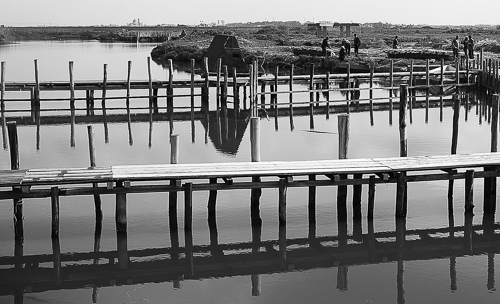The Sinis area offers a cross section of the story of man, dating from the early bronze age to nowadays.
From about 4000 years ago, the presence of man (meaning a settlement whose inhabitants are using and transforming local resources into finished products) is clearly visible in this area.
However, traces of man in this area are clearly visible from numerous archaeological finds dating from 6000-2000 years B.C., via the nuragic age (imposing stone monuments) 1800-800 B.C., a Phoenician settlement being developed simultaneously (1200-800 B.C.) and in harmony with the natives during the nuragic age. The Phoenicians also founded the city of Tharros, followed by the Carthaginians and the Romans in the same city, being occupied by the Aragonese in the 1400s followed by the Genovese before being taken over by fishermen.
From the beginning of the 1900s to the 1970s the fisheries were managed by a man called Don Efisio Carta, who bought them from a Genovese family. The fishermen of Cabras succeeded in obtaining direct control of the fisheries, but only after numerous quarrels and brawls, resulted in the mediation of the Sarda region in the 70s. Then, the fisheries became the property of the Sardinian State, while control of the fisheries were given to the fishermen. Now, management of this enterprise has been assigned to a consortium consisting of 11 cooperatives of fishermen.
Currently, the fishing activity and the processing of the fish, that is turning it into salted, pressed and dried roe, called bottarga, of the flathead mullet and the “Liza Ramada” (classical, roasted mullet) is managed by the cooperatives and a society which has developed a series of activities for tourists interested in fishing at the fisheries, a restaurant with a wide selection of typical sea meals together with educational visits at the fisheries.
The president of the society, Carlo Ferrari, showed us the canal which is closed at specific times of the year by means of wooden barriers and constructed manually by the fishermen, using, according to ancient traditions, reeds which are growing along a lagoon located nearby.
The wetlands, consisting of canals and lagoons, near Cabras has an extension of about 2400 hectares. Between November and April, the reed barriers are removed in order to let the fish mainly consisting of mullet, but also including gilt-head bream and European seabass, etc enter the lagoons. The fish find an ideal environment for grazing in the lagoons, mainly eating what resides on the seabed. When sea water is entering the canals and the lagoons in May, the fish start swimming against the current towards the sea in order to spawn. Then, the fishermen enter the canal, which has been already closed off by means of the wooden barriers, forming a semicircle in front of the barrier and enclosing the fish carefully by means of nets. Then, the fish are taken inside the weighing room, its name deriving from the time when the fish were weighed and sold inside this building to customers from all over Sardinia.
In addition to the buildings meant for weighing the fish and probably constructed some time between 1300 and 1400, on a sand dune, between the two canals, which divide the fishery in two, we can observe many buildings (like a tiny village). One building which differed from the rest was originally used for smoking the roe of the mullet. Another interesting building was a small church dedicated to San Vincenzo (the patron saint of fishermen) together with the guard tower built during the same period as the church.
Given a human presence in this area dating back thousands of years, one can easily deduce that fishing of the mullet and production of the salted, pressed and dried roe, called bottarga, forms the base of a tradition going back to prehistory. These fisheries form an important part of European fisheries, exporting their products to many countries.

